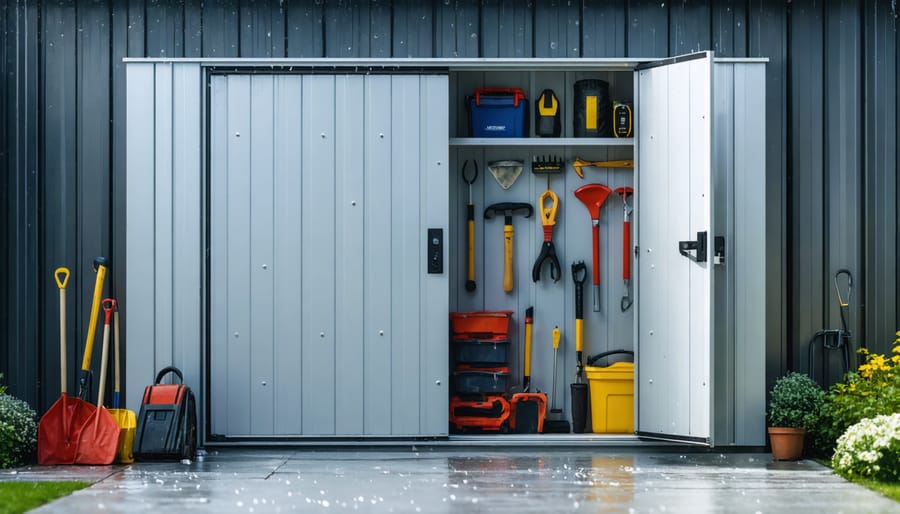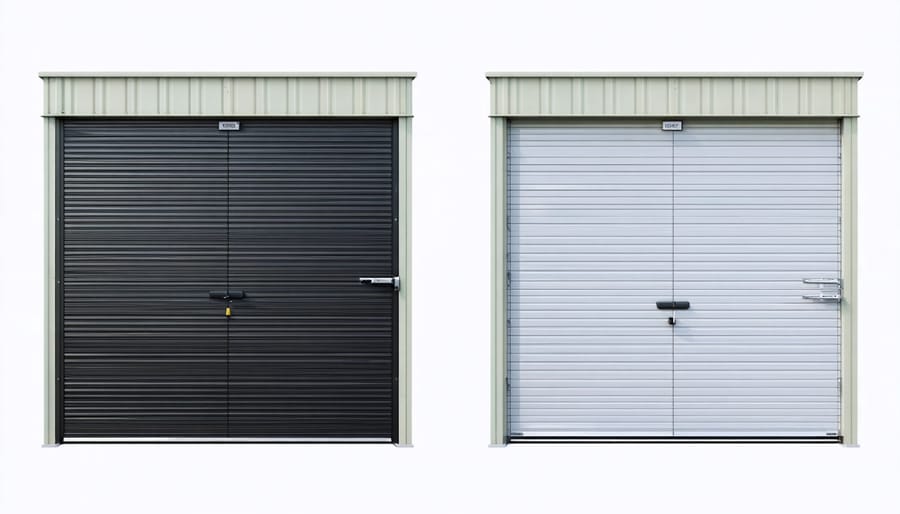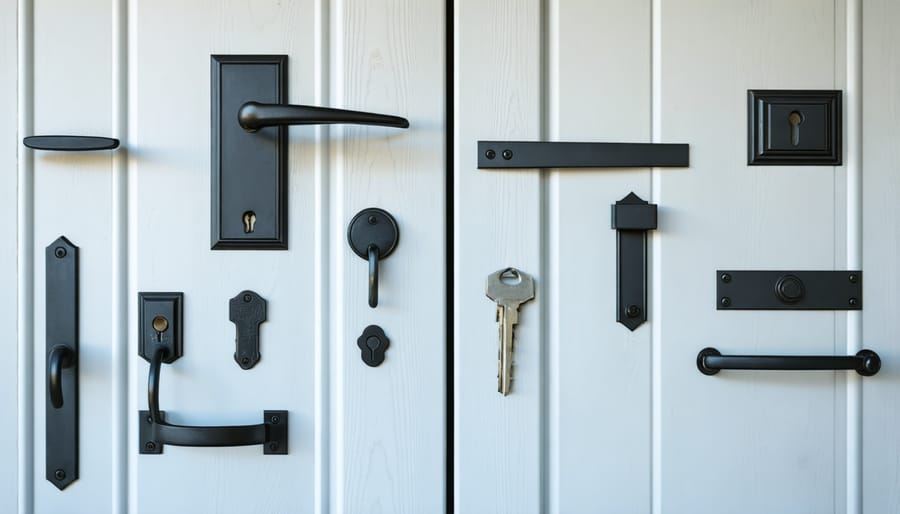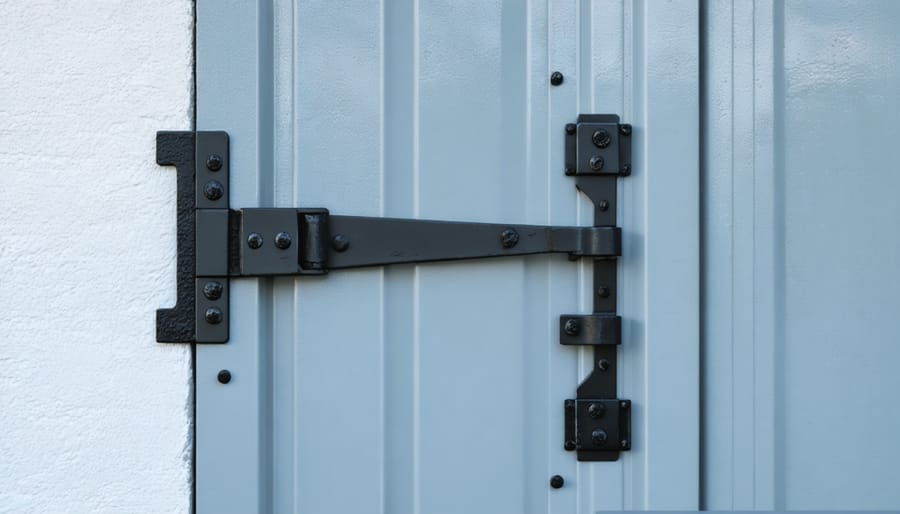Metal Storage Shed Doors: Essential Tips for Security and Smooth Operation

Transform your storage space with robust, secure metal storage shed doors that enhance both functionality and curb appeal. As a cornerstone of metal sheds, these doors offer unmatched durability against harsh weather conditions while protecting valuable belongings. Modern metal shed doors combine heavy-duty steel construction with smooth-rolling tracks and advanced locking mechanisms, delivering the perfect balance of accessibility and security. Whether you’re storing garden equipment, workshop tools, or seasonal decorations, choosing the right door system ensures years of trouble-free operation while maintaining your shed’s structural integrity. From sliding panels to traditional swing doors, today’s options accommodate various space configurations and usage patterns, making it easier than ever to find the perfect fit for your storage needs.
Common Types of Metal Storage Shed Doors
Hinged Single and Double Doors
Hinged doors are a classic choice for metal storage sheds, offering wide access and reliable performance. Single doors work perfectly for smaller sheds, providing easy entry while maximizing interior wall space for storage. Double doors, on the other hand, create a generous opening that’s ideal for moving larger equipment like riding mowers or bicycles.
These traditional swing-out doors come with several advantages. They’re typically more weather-resistant than sliding options, thanks to their overlapping seals and sturdy hinges. Installation is straightforward, and most models include pre-drilled holes for simple alignment. Many homeowners appreciate the satisfying click of a well-fitted hinged door and the ability to add extra security features like padlocks or deadbolts.
For enhanced durability, look for doors with reinforced edges and quality hardware. A slight slope in the threshold helps prevent water from seeping inside during rain, while rubber seals around the frame keep dust and drafts at bay.

Sliding Doors
Sliding doors are a game-changer for metal storage sheds, offering an elegant solution to space constraints. Unlike traditional swing doors, these doors slide horizontally along tracks, eliminating the need for clearance space in front of your shed. This makes them perfect for narrow pathways or when you need to position your shed close to walls or fences.
Many homeowners appreciate how sliding doors provide wider access points, making it easier to move large equipment like riding mowers or workbenches. The track system typically features smooth-rolling wheels on top or bottom rails, ensuring easy operation even with heavy-duty metal doors. Most modern sliding door systems come with anti-lift mechanisms and sturdy locks for added security.
For the best performance, look for doors with weather stripping and sealed tracks to prevent water infiltration and keep your stored items dry. While slightly more expensive than hinged options, sliding doors offer long-term value through their space efficiency and durability.
Roll-Up Doors
Roll-up doors offer a practical solution for larger storage needs, combining easy access with space efficiency. These doors work like miniature garage doors, rolling up smoothly into a compact coil at the top of the opening. They’re particularly popular for wider shed entrances, typically ranging from 6 to 12 feet, making them perfect for storing lawn tractors, ATVs, or multiple pieces of equipment.
Most roll-up doors for metal sheds come in galvanized or painted steel, offering excellent durability and weather resistance. They feature a spring-assisted mechanism that makes opening and closing surprisingly effortless, even with larger sizes. Many models include a lock bar or cylinder lock for security, while premium versions might offer automatic operation with remote controls.
One significant advantage is their minimal space requirement – unlike swing doors, they don’t need clearance space in front of or behind the shed. Just remember to regularly lubricate the tracks and springs to maintain smooth operation.
Essential Door Features and Security Options
Lock Systems and Security Hardware
When it comes to protecting your belongings, a reliable locking system is essential for your metal storage shed door. The most common and cost-effective option is a hasp and padlock combination, which allows you to choose your own lock strength. For enhanced security, consider a heavy-duty deadbolt system specifically designed for shed doors.
Many modern metal shed doors come with built-in cylinder locks that work similarly to your home’s door locks. These offer convenience and better weather resistance since they’re integrated into the door design. For extra peace of mind, you might want to add a door alarm or wireless security sensor that connects to your home security system.
Remember to look for tamper-resistant hardware when selecting your locks. Features like security hinges with non-removable pins and reinforced strike plates can significantly boost your shed’s security. Some shed owners also install motion-sensor lights near their shed entrance as an additional deterrent.
For valuable equipment storage, consider a multi-point locking system that secures the door at several points along the frame. While these systems cost more upfront, they provide superior protection against break-in attempts and often come with warranty coverage.

Weather Sealing and Insulation
Proper weather sealing and insulation are crucial for protecting your stored items from moisture, temperature fluctuations, and weather damage. Start by checking the rubber gaskets around your metal shed door – these create a tight seal when the door closes, preventing water and drafts from entering. Replace any worn or cracked gaskets immediately to maintain effectiveness.
Consider insulating your storage shed doors with foam board or reflective insulation to regulate temperature and prevent condensation. This is especially important if you’re storing temperature-sensitive items or using your shed as a workspace.
Weather stripping along the door frame provides an additional barrier against the elements. Choose adhesive-backed foam tape or brush-style strips that can withstand frequent door movement. Don’t forget about the bottom of the door – installing a door sweep or threshold seal prevents water from seeping underneath and keeps out unwanted pests.
For added protection, apply silicone caulk around the door frame’s exterior to seal any gaps. This simple step can significantly improve your shed’s weather resistance and help maintain a dry, secure storage environment.
Door Frame Reinforcement
A sturdy door frame is essential for preventing common issues like sagging and misalignment in metal storage shed doors. Start by installing metal L-brackets at each corner of the frame, securing them with rust-resistant screws. Adding a diagonal support brace across the frame provides extra stability and helps distribute weight evenly. For maximum reinforcement, consider installing a steel threshold plate at the bottom of the frame to prevent water damage and maintain structural integrity.
If you notice early signs of frame weakness, don’t wait for the problem to worsen. Apply metal corner braces to strengthen joints and ensure all mounting screws are tight. Weather stripping not only improves insulation but also helps stabilize the frame by filling gaps. For older sheds, replacing rusted frame sections with galvanized steel components can extend your door’s lifespan significantly.
Maintenance and Troubleshooting
Regular Maintenance Tasks
To maximize your shed’s lifespan, regular maintenance of your metal storage shed doors is essential. Follow these simple steps every three months:
Start by inspecting the door tracks and hinges, removing any dirt, leaves, or debris with a brush. Apply a silicone-based lubricant to all moving parts, including rollers, tracks, and hinges, ensuring smooth operation.
Check all hardware, including screws, bolts, and handles, tightening any loose components. If you notice rust forming, gently sand the affected area and apply a rust-resistant primer followed by touch-up paint that matches your door’s finish.
Examine the weather stripping around the door frame and replace if it shows signs of wear or damage. This helps prevent moisture from entering your shed. Clean the door surface with mild soap and water, using a soft cloth to avoid scratching the metal finish.
Test the door’s alignment by opening and closing it several times. If you notice any sticking or misalignment, adjust the hinges or tracks as needed. For sliding doors, ensure the bottom track is clear of obstacles that might impede movement.
Remember to address any issues promptly to prevent more significant problems from developing.

Common Problems and Solutions
Metal storage shed doors can experience several common issues, but most have straightforward solutions. If your door is sticking or dragging, check the track for debris and clean it thoroughly. A quick spray of silicone lubricant can often resolve squeaking hinges and rough sliding movements.
For doors that won’t close properly, inspect the frame for any warping or misalignment. Sometimes, tightening loose screws or adjusting the door hinges can fix the gap. If you notice rust forming, remove it with sandpaper and apply rust-resistant paint to prevent further deterioration.
Weather stripping that’s worn or damaged can lead to drafts and water leaks. Replace it promptly to maintain your shed’s weatherproof seal. For dents in the door panel, most small ones can be pulled out using a plunger or dent repair kit.
If the lock mechanism feels stiff, apply a graphite-based lubricant – avoid using oil-based products as they can attract dirt. For severe damage or structural issues, consult a professional to assess whether repair or replacement is the better option.
Remember to address problems quickly to prevent them from becoming more serious and costly to fix.
When to Replace vs. Repair
Consider replacing your metal shed door when rust covers more than 30% of the surface, the door no longer aligns properly with the frame, or if there are significant dents affecting functionality. Repairs are often more cost-effective when dealing with minor issues like squeaky hinges, small rust spots, or loose hardware.
If your door shows signs of warping but still closes securely, a repair might suffice. However, if you notice gaps that compromise security or weather protection, replacement is the better choice. For doors with damaged tracks or rollers, replacement parts can extend their life, but if the door panel itself is compromised, investing in a new door will provide better long-term value.
Always factor in the age of your shed door – if it’s over 15 years old and showing multiple issues, replacement typically offers better returns than continued repairs.
Choosing the right metal storage shed door is crucial for the security, functionality, and longevity of your storage solution. Throughout this guide, we’ve explored various door types, materials, and features that can enhance your shed’s usability and protection. Remember that sliding doors offer space efficiency and smooth operation, while hinged doors provide traditional appeal and robust security options.
When making your final decision, consider your specific needs: available space, climate conditions, and intended use of your shed. If you’re storing larger equipment, double doors might be your best choice. For areas with limited space, rolling or sliding doors could be the perfect solution. Always prioritize weather resistance and durability in your selection, especially if you live in an area with harsh weather conditions.
Maintaining your metal shed doors doesn’t have to be complicated. Regular cleaning, lubrication of moving parts, and prompt attention to any signs of rust or damage will significantly extend their lifespan. Keep the tracks clean for sliding doors, and ensure hinges remain tight and well-oiled for swinging doors. A little preventive maintenance goes a long way in avoiding costly repairs or replacements.
For optimal security, invest in quality locks and consider additional features like reinforced frames or security bars. Many homeowners find that combining different security measures provides the best protection for their stored items.
By following these guidelines and maintaining your doors properly, you’ll enjoy years of reliable service from your metal storage shed doors. Remember, the right door choice paired with proper care isn’t just about protecting your belongings – it’s about peace of mind and long-term satisfaction with your storage solution.

